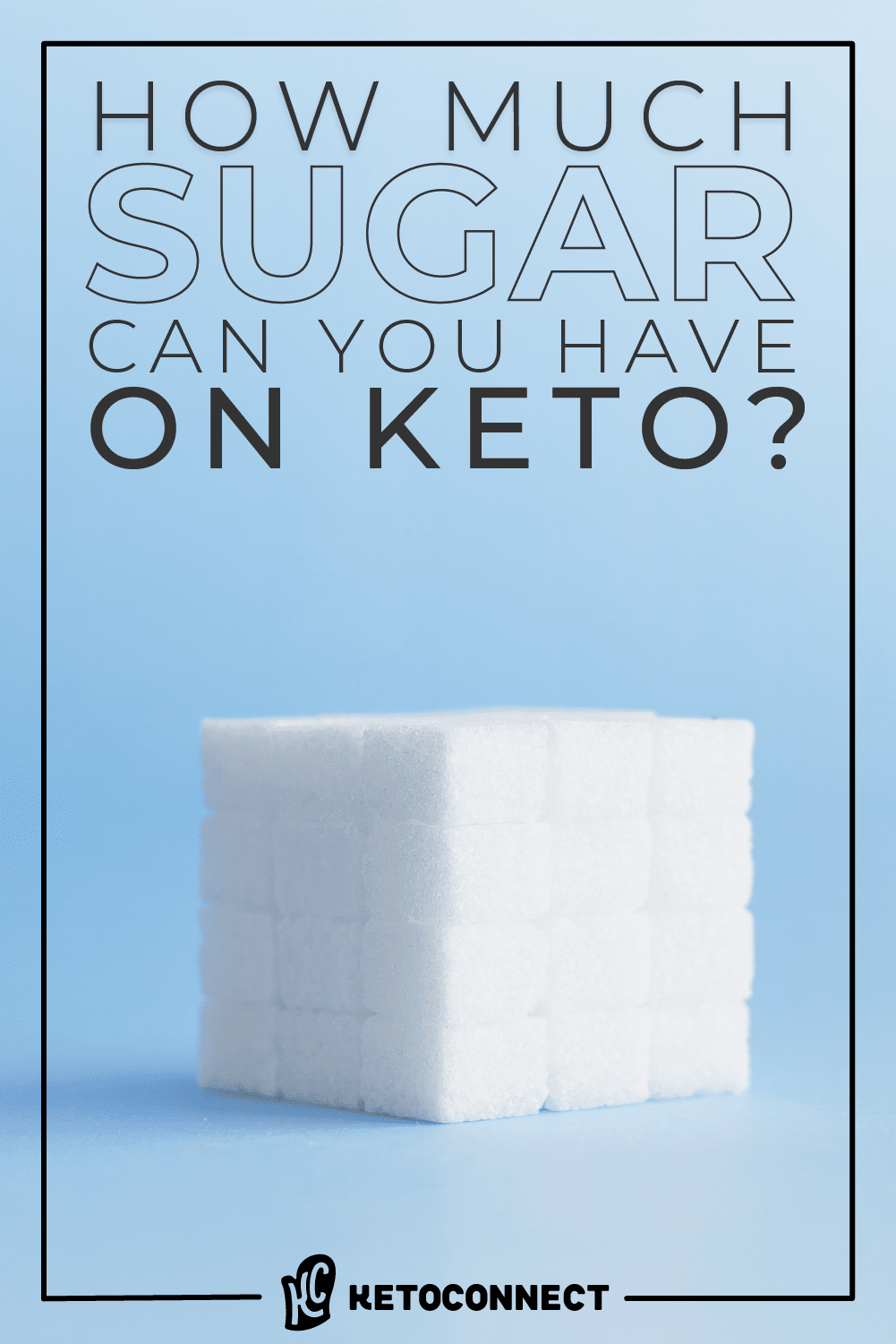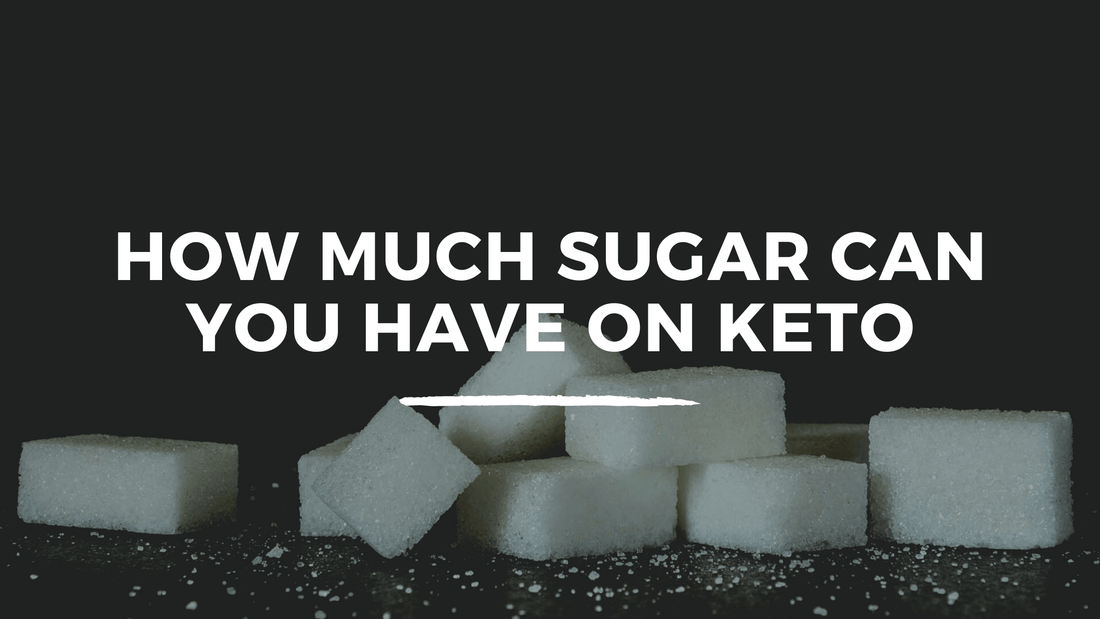Even a minute deviation in sugar intake can disrupt the delicate balance of ketosis. Ever considered how much sugar is too much on a ketogenic diet? Surprisingly, it’s not about zero sugar but maintaining a strict limit that aligns with your carbohydrate thresholds.
Historically, the ketogenic diet emerged in the 1920s primarily for epilepsy management. Today, experts advise keeping daily sugar intake below 20-50 grams of total carbohydrates to sustain ketosis. This equates to roughly 4-10 grams of sugar, providing a framework for bioindividual tweaking.

The Science Behind a Keto Diet and Sugar
The ketogenic diet focuses on low-carb, high-fat foods to switch the body’s energy source from glucose to ketones. When you eat very few carbs, your liver starts producing ketones from fat. This process is called ketosis and is what makes the keto diet effective for many people.
Sugar is a type of carbohydrate that quickly raises your blood glucose levels. This spike in glucose can kick you out of ketosis. Maintaining ketosis requires a careful balance of low sugar intake while consuming other macronutrients properly.
Even small amounts of sugar can impact your keto journey. For example, hidden sugars in processed foods can add up and exceed your daily carb limit. It’s important to read food labels carefully to avoid these pitfalls.
Additionally, some people might need to limit their sugar intake more than others to stay in ketosis. Each person’s tolerance to sugar can vary. Regular monitoring and adjustments can help maintain the state of ketosis effectively.
How Ketosis Works in the Body
Ketosis is the state where your body burns fat instead of glucose for energy. When carbohydrate intake is low, the liver converts fat into fatty acids and ketone bodies. These ketones then become the primary energy source, replacing glucose.
This metabolic switch has numerous benefits, including weight loss and increased energy levels. Ketones are a more stable energy source than glucose, preventing energy crashes. It also has positive effects on brain function and mental clarity.
But achieving ketosis isn’t straightforward. It can take several days of low-carb eating to transition to this metabolic state. Many people experience symptoms known as the “keto flu” during this transition period, including headaches and fatigue.
The Role of Insulin and Glucagon
Insulin and glucagon are hormones that play a significant role in metabolism. Insulin helps regulate blood sugar by enabling cells to absorb glucose. When you consume sugar, insulin levels spike to manage the incoming glucose.
Glucagon, on the other hand, works in opposition to insulin. It helps break down stored sugar and fat for energy when glucose levels are low. In a ketogenic diet, the reduced carb intake lowers insulin levels, promoting fat breakdown.
Lower insulin levels also mean that your body is less likely to store fat. Instead, fats are used for energy, aiding in weight loss. Understanding these hormonal changes can help in better managing your diet.
Impact of Sugar on Ketosis
Sugar consumption directly impacts your ability to stay in ketosis. Even small quantities can spike your blood glucose levels. High blood sugar releases insulin, which inhibits ketone production.
If you consume more sugar than your body can manage, it will store the excess as fat. This storage process prevents fat burning and disrupts ketosis. Consistent high sugar intake can completely negate the benefits of a ketogenic diet.
Limiting sugar and choosing low-glycemic foods can help maintain steady blood sugars. This control makes it easier to stay in ketosis and reap its full benefits. Monitoring your sugar intake is key to keto diet success.
Understanding the Relationship Between Sugar and Carbs
Sugar and carbs are closely linked, but do you know how? All sugars are carbohydrates, but not all carbohydrates are sugars. Understanding this relationship is key to managing your intake on a keto diet.
Carbohydrates come in two main types: simple and complex. Simple carbs, like sugar, are quickly absorbed into the bloodstream. This rapid absorption causes a spike in blood glucose levels, impacting ketosis negatively.
Complex carbs, like those found in vegetables and whole grains, break down more slowly. This slower process prevents spikes in blood sugar levels. By focusing on complex carbs, you can maintain steadier energy levels.
Limiting both simple and complex carbs is essential for staying in ketosis. Read food labels and be aware of hidden sugars in your diet. This awareness helps you stay within your daily carb limit effectively.
Types of Carbohydrates
Carbohydrates come in various forms, each affecting the body differently. There are simple carbs, often found in fruits, sweets, and processed foods. These are easy to break down, causing quick energy spikes.
Complex carbs, on the other hand, are found in vegetables, grains, and legumes. They have longer chains of sugar molecules, making them slower to digest. This slower digestion leads to gradual energy release, which is more stable.
Both types of carbs can impact your ketogenic diet. Avoiding simple carbs and focusing on low-glycemic, complex carbs can help maintain ketosis. Understanding these differences helps in making better dietary choices.
Hidden Sources of Sugar
Even if you’re careful, sugar can sneak into your diet in unexpected ways. Many processed foods contain hidden sugars that you might not notice. These include sauces, dressings, and even so-called “healthy” snacks.
- Sauces and dressings
- Flavored yogurts
- Packaged snacks
Reading food labels helps identify these hidden sugars. Look for ingredients that end in ‘-ose’, like fructose or glucose. This vigilance can help you avoid exceeding your carb limit unknowingly.
Impact on Your Keto Diet
Excess sugar not only affects your blood sugar levels but also disrupts ketosis. When you consume more sugar than your body can handle, it gets stored as fat. This storage process inhibits your body’s ability to burn fat for energy.
Even small amounts of hidden sugars can add up, making it easier to exceed your daily carb limit. This excess can lead to losing the benefits of being in ketosis. Consistently monitoring your sugar intake can help you stay on track.
Maintaining a balanced ketogenic diet involves more than just avoiding obvious sugars. Understanding the relationship between sugar and carbs offers a more comprehensive approach to staying in ketosis. This understanding makes it easier to maintain your keto goals.
Common Sugar Sources to Avoid in a Keto Diet
Avoiding sugar on a ketogenic diet is crucial for maintaining ketosis. Many foods contain hidden sugars that can sabotage your efforts. Even small amounts can add up quickly, pushing you over your daily carb limit.
Sugary drinks are one of the biggest culprits. Sodas, energy drinks, and even fruit juices are packed with sugar. Replacing these with water or unsweetened beverages can make a significant difference.
Processed snacks and sweets also pose a hidden risk. Foods like candy, cookies, and even some granola bars are loaded with sugar. Opting for keto-friendly snacks like nuts or cheese can help keep your carb count in check.
Condiments and sauces often contain hidden sugars as well. Ketchup, barbecue sauce, and salad dressings can be surprisingly high in sugar. Choosing sugar-free or homemade versions can help you stay true to your keto diet.
How Much Sugar is Allowed on a Keto Diet
Staying in ketosis requires very low sugar intake. The general guideline is to keep your total carbohydrate intake between 20-50 grams per day. This includes all sources of carbs, even hidden sugars in foods.
For most people, keeping sugar intake to less than 5% of daily calories is a good rule. This often translates to about 4-10 grams of sugar per day. Monitoring your total carbohydrate intake helps ensure you stay in ketosis.
Different people’s tolerance to sugar varies. Some might stay in ketosis with slightly higher levels, while others need very strict limits. Experimenting and tracking are key to finding your sweet spot.
Using natural sweeteners like stevia can help manage cravings without affecting ketosis. These alternatives are typically low or zero-carb. They offer sweetness without the metabolic repercussions of sugar.
It’s important to read nutrition labels diligently. Hidden sugars can sneak into your diet, especially in processed foods. Staying vigilant will help you maintain your carb limits effectively.
If you exceed your sugar limit, your body will revert to burning glucose instead of fat. This disrupts ketosis and slows down progress. Being mindful of your sugar intake ensures you reap the full benefits of a keto diet.
Natural Low-Sugar Alternatives for Your Keto Diet
Finding low-sugar alternatives is crucial for maintaining ketosis while enjoying sweet flavors. Stevia is a popular option that is zero-calorie and doesn’t impact blood glucose levels. It is derived from the leaves of the Stevia plant.
Erythritol is another excellent choice. This sugar alcohol has almost no calories and does not spike blood sugar or insulin levels. It can be found in various low-carb desserts and snacks.
Monk fruit extract is gaining popularity as a sweetener. It is much sweeter than sugar but contains no calories or carbohydrates. This makes it perfect for keto-friendly recipes.
Xylitol is a sugar alcohol that can be used in baking and cooking. It has fewer calories than sugar and a low glycemic index. However, it’s essential to use it sparingly, as it can cause digestive issues for some people.
Coconut sugar, while not entirely carbohydrate-free, has a lower glycemic index than regular sugar. It offers a sweet flavor with some nutritional benefits. It’s best used in moderation to avoid disrupting ketosis.
By incorporating these alternatives, you can enjoy a variety of sweet treats without exceeding your carb limits. Reading labels and choosing the right products helps maintain your keto diet effectively.
Monitoring Your Sugar Intake In a Keto Diet
Keeping track of sugar consumption is vital for success on a keto diet. Detailed tracking helps ensure you stay in ketosis. Using apps like MyFitnessPal can simplify this process.
Reading nutrition labels is also crucial. Hidden sugars in processed foods can quickly add up. Be sure to check both total carbohydrates and sugars listed on packaging.
Maintaining a food journal can be highly effective. Write down everything you eat and drink throughout the day. This practice can reveal patterns and help you make better dietary choices.
Regular monitoring can help identify foods that might be affecting your ketosis. By tracking your reactions to certain foods, you can adjust your diet accordingly. This personalized approach increases your chances of long-term success.
Using measuring tools can be beneficial. Kitchen scales and measuring cups ensure accurate portion sizes. Precise measurement ensures you don’t unintentionally exceed your sugar limit.
Finally, regularly check your ketone levels. Tools like blood ketone meters or urine test strips can give you quick feedback. This data helps you adjust your diet to stay in the optimal ketosis range.
Key Takeaways
- Keep total carb intake between 20-50 grams per day on keto.
- Daily sugar intake should be around 4-10 grams to stay in ketosis.
- Monitoring carbohydrate intake is crucial for maintaining ketosis.
- Keto diet includes all sources of sugars and carbohydrates.
- Regular tracking helps ensure you remain in nutritional ketosis.

Frequently Asked Questions
Understanding sugar intake on a ketogenic diet can be challenging. Here are some common questions answered to help you stay informed.
1. What role does sugar play in ketosis?
Sugar can disrupt the state of ketosis because it spikes blood glucose levels. This spike forces the body to use glucose for energy instead of ketones from fat. Hence, keeping sugar intake minimal is necessary to maintain ketosis.
When you eat too much sugar, your insulin levels rise, and ketone production decreases. This activity makes it hard for your body to stay in keto mode and reap its benefits effectively.
2. Can I have any fruit on a keto diet?
Yes, but in moderation, focusing on low-sugar fruits like berries. Fruits high in sugar can quickly add up your daily carb limit and kick you out of ketosis.
Berries like strawberries, raspberries, and blackberries are usually safe options. Still, it’s essential to watch your portions and track how these fruits affect your carb count.
3. Why do some people react differently to sugar on keto?
Individual tolerance to sugar varies due to metabolic differences such as insulin sensitivity and activity level. Some might maintain ketosis with slightly higher sugars; others need stricter limits.
It’s crucial to experiment and monitor how different foods impact your body. Keep a food diary or log data into an app for practical insights into what works best for you.
4. Are artificial sweeteners safe on a keto diet?
Many artificial sweeteners can be used safely without disrupting ketosis since they do not break down into glucose in the body. However, it’s essential to understand that reactions vary among individuals.
Sugar substitutes like stevia or erythritol are popular choices on keto diets because they offer sweetness without added carbs or calories. It’s wise though to monitor how these sweeteners affect you over time.
5. How can hidden sugars affect my keto progress?
Hidden sugars found in processed foods can quickly add up without you realizing it, possibly exceeding your daily carb limit unknowingly. Common items include sauces, dressings, and “healthy” snack bars that may seem harmless but contain sugars.
This makes label-reading crucial; scan ingredient lists for terms like “syrup” or anything ending in “-ose.” Being vigilant helps maintain stable blood glucose levels essential for staying in ketosis effectively.

Conclusion
Maintaining a ketogenic diet requires diligent monitoring of sugar and carbohydrate intake. By understanding the relationship between sugar and ketosis, you can make more informed food choices. This balance ensures you stay within your carb limits and reap the full benefits of the diet.
Using natural, low-sugar alternatives and being mindful of hidden sugars can help you stay on track. Tools like food journals and nutrition apps make this task manageable. By staying vigilant, you can achieve and maintain ketosis effectively.
